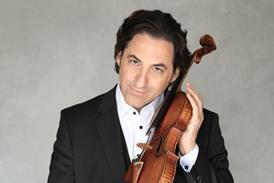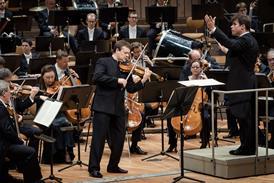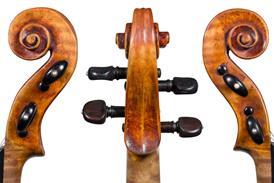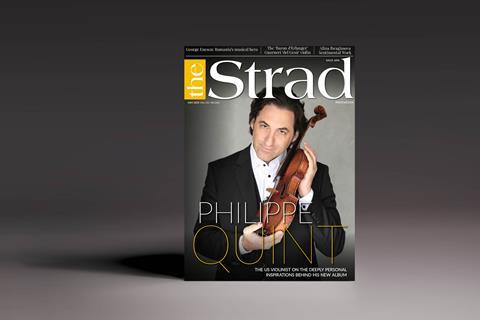US correspondent Thomas May speaks with Ayane Kozasa and Paul Wiancko of the Kronos Quartet about the dramatic change in the ensemble’s lineup that began with the current season.

Discover more Featured Stories like this in The Strad Playing Hub
Having celebrated its 50th anniverary last season, the Kronos Quartet has already begun its latest chapter with a dramatic change in the ensemble’s makeup. Longtime members John Sherba (violin) and Hank Dutt (viola) retired at the end of June, leaving violinist David Harrington, who founded Kronos, as the sole remaining member from the early years. Dutt had been part of Kronos since 1977, while Sherba joined them in 1978. Cellist and composer Paul Wiancko began his relationship with the quartet in 2019 and took the place of Sunny Yang in February 2023. Violinist David Harrington, who founded Kronos, is the only member who now remains.
The two newcomers are violinist Gabriela Díaz and violist Ayane Kozasa. A member of ICE, A Far Cry and Boston Modern Orchestra Project, Díaz has worked closely with many leading composers (incuding such figures as Pierre Boulez, Joan Tower, Steve Reich, Helmut Lachenmann and Tania León). Kozasa won the Primrose International Viola Competition in 2011 and co-founded the Aizuri Quartet. Both are also dedicated teachers (on the faculty of Wellesley College and the University of Cincinnati College-Conservatory of Music, respectively).
Kronos began performing with its new lineup this season, giving its first public concert in Vancouver, British Columbia, on 26 October. The Strad caught up with Wiancko and Kozasa at the end of a recent series of European performances at the Cartegena Jazz Festival, at BOZAR in Brussels and at the Blå Jazz Club in Oslo.
’We just played in this tiny rock club last night, which was packed to the gills, with everybody standing up’, said Wiancko at the beginning of a joint Zoom conversation from Oslo. ’It was almost like going back to the roots of Kronos’.
Ahead of their 23 November performance at the New Jersey Performing Arts Center, which will pay homage to the Civil Rights icon Mahalia Jackson, Wiancko and Kozasa, who are also partners, shared their perspectives on being part of Kronos and how the new formation is shaping the storied ensemble.
Paul, you’re already a veteran of the group, relatively speaking. What did it feel like when you started out with Kronos?
Paul Wiancko: It was a total dream come true: as a cellist and as a composer and as a Kronos fan. For me, as for many of my colleagues, my first album was Black Angels, which I discovered when I was a little too young for it, at eight or nine years old. It scared the crap out of me! But it blew my mind and opened up my concept of what a life in music could mean. I spent the next 30 years searching and carving out my own path. In college I started taking studio recording very seriously, and then that morphed into more experimental music and arranging music and then composition. So it was like coming full circle to be invited to join Kronos. When I agreed to join, I was already on the composer path. I had never expected to be in a string quartet until, until I got that call.
And for you, Ayane?
Ayane Kozasa: Same as Paul, I never imagined I would be a part of Kronos. My first experience with Kronos music was their Sesame Street appearance. At a young age, it was pretty special to know that the tiny violin I was playing on at the time could be featured on Sesame Street. When I was older, I realised that it was all new music. That was so inspiring.
The difference from Paul is that I always wanted to be in a string quartet. I grew up playing violin, but my three best friends were two violinists and a cellist, so when we wanted to start a band I decided to switch to viola and never looked back. I’ve been on a chamber music-focused path since then as a member of different ensembles.
There was a moment when I realised that I wanted to start focusing on concert experiences that had a sense of purpose by sharing stories that are necessary for the world. I felt incredibly lucky that this opportunity came up with Kronos. It’s not just the music that we play but also the causes that we want to be a part of and fight for as part of the music and beyond the music. That’s incredibly special and rewarding.
How did the process of being invited to join unfold?
Paul Wiancko: In 2019 I had subbed in with Kronos for a few months when Sunny Yang was on maternity leave. At that time, I was writing a piece for the quartet. I thought: I’m going to become the first-ever composer to be able to play in Kronos while writing a piece for the group – the ultimate cheat code to make this piece a great one for the group. Then Covid hit, and Sunny decided to leave a couple years later. We had had such great chemistry during those few months in 2019 that I was the only call they made. Within 60 seconds, before checking with any of my loved ones or any of my family, I agreed to join Kronos.
When [violist] Hank Dutt – one of the sweetest human beings I’ve ever met in my entire life – decided to retire, his only suggestion for his successor was Ayane. ‘I’ve been stalking her online and watching all of her videos, and you guys should really consider it’, he said. I recused myself because we were already a couple at that time. We read through about 30 different pieces in Ayane’s audition.
It was really important to us that Hank was a big part of this decision, in terms of legacy, and that the next person needed to understand him and what Kronos has been building. So Ayane was invited into the group when we still had four or five more months of touring left [early in 2024]. She joined us on the tour, and Hank mentored her in all the details, like how to fill the wine glasses for Black Angels. It was a beautiful thing to watch the torch slowly be passed on.
How did the transition from your previous chamber experiences work for you, Ayane – for example, from your experience playing as duo with Paul? Did you feel you needed to adapt in any special way?
Ayane Kozasa: One big but super fun change has been sitting on the inside of the quartet. I’ve always sat on the outside, across from the first violin, which is the American tradition. The first time that I sat on the inside was during the audition, and Paul was the cellist. The sound was coming in through my left ear, which was a crazy feeling. I realised that I’ve never had an opportunity for the sound to come through both ears like that. It had always been through my right ear. I remember this different sensory experience that I’d never experienced before.
Paul and I have always loved playing together as a duo. We know that our sounds blend well together. Part of it is that, rather than being violin and cello or violin and viola, we’re both very used to being support sounds. Being able to do that together for two other violinists is really nice.
Paul Wiancko: That’s very true. The nature of the roles of viola and cello in an ensemble is very much our nature as human beings as well. It’s much more satisfying to help something go smoothly than to be the one being helped. As the viola and cello in an ensemble, you don’t get as much of the glory, but you’re secretly in control all the time, making sure the violins sound as good as they possibly can.
The seating is really important for Kronos, I’ve come to find. I’m also used to usually sitting in the middle as the cellist in American ensembles. But for Kronos repertoire, it’s important for David [Harrington] and me to have direct visual communication at all times, because the music of Kronos goes so far beyond classical Western music. Often people write for us the way they would write for a band – rock, tango, folk, or mariachi ensemble – where the voice and the bass (or percussion) need to be in direct communication, which is generally represented by me and David, and then the inner voices are sort of a unit. So Ayane and Gabriela sitting together create that nucleus of the quartet.

Had either of you played before with Gabriela before she came on board as the new violinist?
Ayane Kozasa: A couple of times, in some ad hoc chamber music groups.
Paul Wiancko: Here and there, and we had interacted with her as a friend and a colleague. She’s a force of nature and has premiered pieces by some of the greatest recent composers of all time.
Ayane, how have you and Gabriela bonded together as the two newcomers?
Ayane Kozasa: Right before rehearsal, we ask each other: OK, what are the things that we feel the least familiar with, what do we need to work on? David and Paul are so kind to rehearse whatever we need as newbies. The thing that we share in personality is a love for new things and new experiences – even if we don’t totally grasp what it is or what we’re about to get into. For me, there’s no point in worrying about something that I don’t know, so I might as well just dive in, and Gabriela feels the same way. That enthusiasm for the unknown has made her such a comforting soulmate to have next to me – and also as inner voices. I love playing with her, because our sounds match really well.
Paul, from your perspective have you already sensed any change in the chemistry of the sound? Is it too early to tell?
Paul Wiancko: Yes and no. With Kronos, it’s more about the flexibility of sound than a signature sound, because every piece we play requires something completely different. It could be trying to imitate Indonesian gamelan music written by our friend Peni Candra Rini from Java and imitating her vocals, and then it’s Nina Simone or Jimi Hendrix or Terry Riley. It’s about the quality of listening and how well you can adapt and your range of sound. Both Gabriela and Ayane bring a huge range. Part of that is from their deep understanding of Kronos for years. David has said a few times in interviews that Gabriela and Ayane know our music better than we do.
With Kronos, it’s more about the flexibility of sound than a signature sound, because every piece we play requires something completely different
No one could ever replicate John Sherba and Hank Dutt’s sound or their way of playing. But you can be inspired by that and incorporate that into your own sound. Gabriela and Ayane do just that. We just played Steve Reich’s Triple Quartet last night, where the live version of Kronos is playing with two historically significant recordings of two other Kronos Quartet formations featuring John and Hank. So the four of us become just one-third of the performers – and you can’t tell who is playing what. What a beautiful thing that we can still play with the original members of Kronos in that way.
Do you foresee any shift in direction in terms of repertoire or focus going forward?
Paul Wiancko: My horizons are continuing to expand based on the way Kronos works and the privilege of having the platform of Kronos with its legacy of 50 years. It changes you and it changes your concept of what a string quartet can do and of the role of music in society. The spirit of Kronos with regard to programming is already that there are no rules. We’re really running with that.
Ayane Kozasa: We just picked up some new Hardanger instruments that were made for us by the Norwegian master luthier Ottar Kåsa. We’re going to use them to play a new collaboration written for us by the Norwegian artists Benedicte Maurseth and Kristine Tjøgersen at Carnegie Hall in March. It’s a 40-minute piece on a climate change theme incorporating imagery of flora and fauna and animal sounds from the plains of Hardanger [in southwestern Norway] and incorporating animal sounds.
Paul Wiancko: It’s the first time Kronos will be transformed into a Hardanger quartet. The scrolls of our instruments all have a lion with its tongue sticking out. That’s a very Kronos kind of image!
 The Kronos Quartet makes their first happy encounter with their new hardanger instruments; at center, master luthier Ottar Kåsa
The Kronos Quartet makes their first happy encounter with their new hardanger instruments; at center, master luthier Ottar Kåsa
Listen: The Strad Podcast Episode #39: Kronos Quartet’s David Harrington on musical activism
Read: Kronos Quartet at 50: Hunger for the new
Discover more Featured Stories like this in The Strad Playing Hub.
The number one source for playing and teaching books, guides, CDs, calendars and back issues of the magazine.
In The Best of Technique you’ll discover the top playing tips of the world’s leading string players and teachers. It’s packed full of exercises for students, plus examples from the standard repertoire to show you how to integrate the technique into your playing.
The Strad’s Masterclass series brings together the finest string players with some of the greatest string works ever written. Always one of our most popular sections, Masterclass has been an invaluable aid to aspiring soloists, chamber musicians and string teachers since the 1990s.
The Canada Council of the Arts’ Musical Instrument Bank is 40 years old in 2025. This year’s calendar celebrates some its treasures, including four instruments by Antonio Stradivari and priceless works by Montagnana, Gagliano, Pressenda and David Tecchler.






































No comments yet